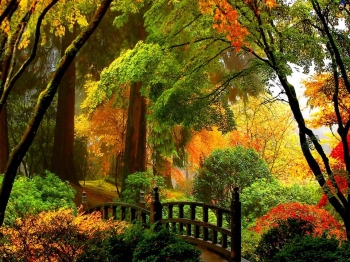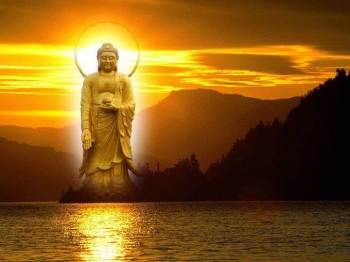In the Infinite Life Sutra, one of the main texts of the Pure Land tradition, Amitabha Buddha made his 18th vow:
“If, when I attain Buddhahood, sentient beings in the lands of the ten directions who sincerely and joyfully entrust themselves to me, desire to be born in my land, and recite my Name, even ten times, should not be born there, may I not attain perfect Enlightenment. Excluded, however, are those who commit the five gravest transgressions and slander the right Dharma.”
However, the Contemplation Sutra says something quite different:
“Those who attain rebirth on the lowest level of the lowest grade are the sentient beings who commit such evils as the five gravest transgressions, the ten evil acts and all kinds of immorality.” If they follow a good person’s advice at the near end of their lives,and “sincerely and continuously say 'Homage to Amitayus Buddha' [Namo Amituofo] ten times”, they will eventually be reborn inside the lotus-bud in the Land of Bliss. The lotus-bud will blossom after twelve great kalpas.
I discussed one ‘discrepancy’of the five gravest transgressions in these two passages in my last article. There is, however, a second. In a rebirth on the lowest level of the lowest grade, a believer will be reborn in the Pure Land by sincerely reciting “Namo Amituofo” even only ten times, in compliance with the conditions stated in the 18th vow. He is supposed to stay inside the lotus-bud, known as the ‘land of transformation’, for 12 eons after the bud blossoms.
In the case of the 18th vow, if the adherent sincerely recites even only ten times, he will be reborn in the Pure Land. Lotus-bud, ‘rebirth by womb’ or ‘the land of transformation’ is not mentioned in the vow. Are they the same case? Does it mean that adherents who follow the 18th vow to attain rebirth will also be reborn in the lotus bud in the land of transformation, and then blossom after 12 eons?
Master Shandao emphasized that those who exclusively recite Amitabha’s name in accordance with the fundamental vow will be directly reborn in the ‘land of rewards.’ It means that the reciter is supposed not to stay inside the lotus-bud, because the lotus flower blossoms as soon as he is reborn. Is there a contradiction between the passages in the two sutras?
Two kinds of Pure Land adherents
There are two kinds of Pure Land adherents. One is the practitioner in the present lifetime. These practitioners practice Amitabha-recitation for the sake of rebirth in the Pure Land upon hearing Amitabha’s teachings in their present lifetime. The second is the Pure Land aspirant near the end of life. These aspirants hope to be reborn upon hearing of Amitabha’s teachings, or just his name at the near end of his life, like those described in the three levels of rebirth in the low grade.
I deliberately use ‘practitioner’ and ‘aspirant’ to differentiate two kinds of Pure Land adherents. The latter adherents are ‘aspirants at the near end of life’ because they have not heard and practiced any Amitabha-recitation in their present lifetime, and they simply aspire to be reborn in the Pure Land in order to escape from falling into hells. The former adherents are so called the ‘practitioners in the present lifetime’ because they practice for the sake of rebirth in the Pure Land upon hearing of Amitabha’s teachings in the present lifetime.
Two kinds of assured rebirth
Correspondingly, there are two kinds of assurance of rebirth for Pure Land aspirants. One is rebirth assured in the present lifetime, and the other is rebirth assured near the end of life.For the aspirants at their deathbeds, it is clear that their assurance of rebirth must be achieved at the near end of their life.
However, for practitioners in the present lifetime, their assurance of rebirth may be either achieved in the present lifetime or achieved at the near end of their life, depending on their choice of ‘approach’ and the respective practices. For those who choose the ‘faith’ approach as stated in the18th vow (the Path of Great Vow as classified by Master Shandao), they entrust themselves to Amitabha Buddha, and recite Amitabha’s name for the rest of their life for the sake of rebirth. Their assured rebirth is achieved in the present lifetime.
For those who choose other approaches, like ‘aspiration’ approach as stated in the 19th vow, or ‘practice’ approach as stated in the 20th vow, they do not practice Amitabha-recitation exclusively, but prefer other meditative and non-meditative virtues as stated in the 19th vow and 20th vow, or mixing with other practices with Buddha-invocation. As they continue to dedicate the merits and virtues attained through meditative and non-meditative practices by self-power for seeking rebirth in the Pure Land, they are not sure whether they can maintain their sincere ‘aspiration’ or sincere ‘practice’ until the end of their life, thus they have no full confidence to be reborn in the Land of Bliss in the present lifetime. They cannot tell the chance of their rebirthuntil the near end of their life. Thus, their assured rebirth must be achieved at the near end of life.
Both are reborn under the 18th vow
For aspirants who recite Amitabha’s name for ten times at the end of life, their assured rebirth must be achieved at exactly that time, like those reborn in the low grade. Moreover, as they recite Amitabha’s name and earnestly aspire to be reborn with him at this critical moment, the aspirant fulfills the Three Sambhara – faith, aspiration and practice. Their rebirth is certainly validated under the 18th vow because the other two vows, the 19th vow and 20th vow, are not applicable.
However, for the practitioners who recite Amitabha’s name for the rest of their life in the present lifetime, their rebirth is also assured and validated by the 18th vow. Moreover, as they recite Amitabha’s name exclusively for the rest of their lives, they fulfill eight criteria:
(1) They conform strictly to what Amitabha Buddha tells them to do in the 18th vow;
(2) They entrust themselves to Amitabha Buddha upon hearing his teachings, and do not change their mind for the rest of their life;
(3) They, through exclusive Amitabha-recitation, have genuine faith built on the substantial merits and virtues dedicated by Amitabha Buddha;
(4) They have developed an intimate relationship, close relationship, and augmentative relationship with Amitabha Buddha through exclusive Amitabha-recitation;
(5) They are always embraced and protected by the light of Amitabha Buddha subsequently;
(6) They attain substantial merits and virtues, which are compatible with those in the Land of Bliss, a realm of unconditioned nirvana;
(7) They rely entirely on the vow power of Amitabha Buddha, without any mindset of self-power as far as rebirth in the Pure Land is concerned;
(8) They have full faith in Amitabha Buddha without any doubt in his wisdom and power.
As a result, they are directly reborn in the Land of Rewards with Amitabha’s vow power as an augmentative cause, according to the 18th vow.
Two sides of a coin
In the case of rebirth on the lowest level of the lowest grade, since the adherent aspires to be reborn in the Pure Land (to escape from sufferings in hell), and sincerely recites “Namo Amituofo” even only ten times, he satisfies all the requirements stipulated in the 18th vow. He is also entitled to be reborn in the Pure Land, but will he be reborn in the Land of Rewards (blossomed lotus flower) or the Land of Transformation (inside the lotus bud)?
This is a very sensitive question, as it is arguable whether the Land of Bliss is a Land of Rewards or a Land of Transformation. For now, Master Shandao concluded in his Commentary of the Contemplation Sutra that the Land of Bliss is a land of reward, a realm of unconditioned nirvana. Whether the Land of Bliss is a land of rewards or a land of transformation is just like two sides of a coin.
It should be noted that ‘bud’ is an analogy as compared with the blossomed flower. In any case, it is located in the same piece of land, the Land of Bliss. Even if one lives inside the lotus bud, one is already a being in the Land of Bliss. The Land of Bliss is a realm of unconditioned nirvana, which transcends space and time. Thus, any differentiated depiction and quantified measurement is not applicable. These terms are meaningless in a realm of rewards. These images are only an expedient way for us to interpret and comprehend the unfathomable reality of the Land of Bliss.
The time inside the lotus-bud defined by Shakyamuni Buddha can be regarded as a comparative reference to encourage Pure Land adherents to commit to pure chanting. Differentiated and quantified measurement in space and time is only applicable in a realm of transformation (our material world).
Again, Master Shandao interpreted rebirth on the lowest level of the lowest grade as a preventive measure, in order to prevent practitioners from taking a chance to change from “adherents in the present lifetime” to “adherents at the near end of their life”, and from “rebirth assured in the present lifetime” to “rebirth assured at the near end of their life”. It is very risky because the causal conditions at death are unpredictable and vulnerable. The chance to attain rebirth on the lowest level of the lowest grade at this critical moment is very low.
It is your choice to take the risk. As you are now an adherent in your present lifetime, why not choose rebirth assured in your present lifetime too? As they say, don’t work hard: work smart. There’s no need to choose rebirth assured at the near end of your life. Amitabha Buddha is always with you. Namo Amituofo!
















